Heart-Mind Well-Being Promoted at StrongStart Conference


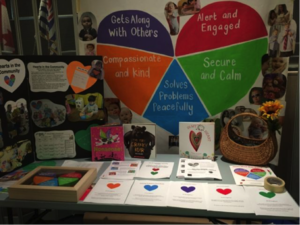 Friday October 2nd, 2015 was the Regional StrongStart Pro-D Learning Together conference in Metro Vancouver. Eight Districts that included Vancouver, Burnaby, Coquitlam, Maple Ridge, New Westminster, North Vancouver, Sunshine Coast and West Vancouver promoted an area of interest to StrongStart Facilitators. In total, 98 facilitators attended the Conference.
Friday October 2nd, 2015 was the Regional StrongStart Pro-D Learning Together conference in Metro Vancouver. Eight Districts that included Vancouver, Burnaby, Coquitlam, Maple Ridge, New Westminster, North Vancouver, Sunshine Coast and West Vancouver promoted an area of interest to StrongStart Facilitators. In total, 98 facilitators attended the Conference.
Vancouver School Board's Strongstart centres promoted Heart-Mind Well-being as our gallery walk display. Facilitators were invited to browse through the materials set up and programs our families at StrongStart participated in to learn about the Five Positive Human Qualities of Heart-Mind Well-being developed by the Dalai Lama Center and UBC's Human Early Learning Partnership. Throughout were examples of how we used books, props, stories, felts and music to promote and foster the five positive qualities: Compassion and Kindness, Gets Along with Others, Alert and Engaged, Secure and Calm, and Solves Problems Peacefully.
We handed out bracelets and posters donated by the Dalai Lama Center and directed everyone to go their Heart-Mind Online website to find resources to promote this peaceful programming in their centers. The Heart-Mind Well-being program was well received and many people took pictures of all the resources and commented on the importance of Social and Emotional Learning in early childhood education. The Dalai Lama Center's Heart-Mind Well-being framework is the basis of a positive, peaceful and successful program for VSB's StrongStart centres, and the interest and response from other district representatives was incredibly positive.
Below is an overview of the types of activities we have incorporated into our Vancouver StrongStart centres based on the Heart-Mind Well-being framework and the five positive human qualities it promotes.
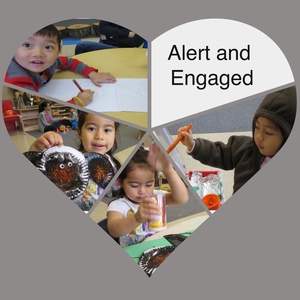 Example: ALERT AND ENGAGED
Example: ALERT AND ENGAGED
1. ART TABLE (varies daily and/or weekly)
Leaf painting; choose your own colours
ALERT AND ENGAGED
Issue being worked on: Process over Product art; let me do my own work.
We are setting up provocations for children to manage and direct their own feelings, thoughts and emotions.
Battles begin when adults "take over" a child's artwork in progress to make it LOOK like something THEY feel it should be, forgetting the experience a child is having just going with the flow in peace and at their own pace, and using resources with their five senses.
Exercising Self-Control and the ability to be "present" by expressing their desire to do their own work, expecting respect when their work is done, and to be given time to enjoy the process are experiences worked on daily in our program.
Adults can do their own artwork and children can relax and do their own artwork. Children have been given a voice by expressing their feelings in a positive and socially acceptable manner.
 Example: GETTING ALONG WITH OTHERS
Example: GETTING ALONG WITH OTHERS
2. DRAMA PLAY AREA
This area is used to "form positive and healthy relationships with peers and adults".
GETTING ALONG WITH OTHERS
Issue being worked on: Battles over certain costumes.
October is fire safety month. We have two fire fighter outfits, hoses, 4 hats and numerous other outfits. Everyone wants to use the two fire fighter outfits at once. Battles begin over specific hats to wear. "Children with better abilities to regulate their emotions and behaviors have more friends and experience more positive playtime with their peers" (HMWB).
Witnessing role-modeling by children that will share, take turns, and/or give in after a short period of time are the best experiences for those that have trouble regulating their emotions and behaviors.
We all learn from each other and positive playtimes mean growth in Social and Emotional Learning. Here we see children being "present" and exercising self-control and self-regulation. They learn to respect the space and belongings and their peer's needs.
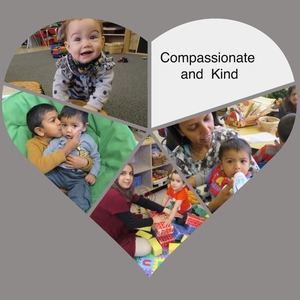 Example: COMPASSIONATE AND KIND
Example: COMPASSIONATE AND KIND
3. BABY AREA
We have an area set up for crawling, climbing and cuddling for babies.
COMPASSIONATE AND KIND
Issue being worked on: Showing compassion and kindness to infants.
Soft toys and books are spread on a blanket. Everyone is invited to the area knowing the rule of being "COMPASSIONATE AND KIND" has to be present and displayed. Many toddlers that are shy and do not like crowds go to this area. Some are crying and in distress as they could be new to our program.
After working on "What does Compassionate and Kindness mean to our group?" at circle times and throughout our program, we've witnessed older children entering that area to comfort children in distress. They will offer toys, a rub on their back, lie on the ground to look eye to eye with the child, and they use soft quiet words.
We have a JAR that anyone can write a note and put in the jar for circle time sharing to the group. Many write moments they witness of compassion and kindness. These could be from adults or children in action. It is important to recognize acts of compassion and kindness as it promotes Social and Emotional Learning.
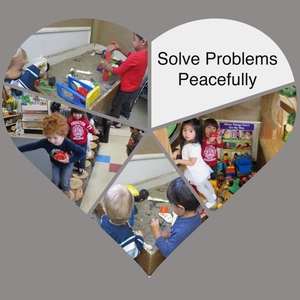 Example: SOLVES PROBLEMS PEACEFULLY
Example: SOLVES PROBLEMS PEACEFULLY
4. SAND TABLE
Set up construction toys, a special shovel, gems, a piece of wood, the sifter in the sand box.
SOLVES PROBLEMS PEACEFULLY
Issue being worked on: Resolving conflicts over using toys in sandbox.
"Managing conflict effectively is about creating an atmosphere where violence and aggression are not likely" (HMWB). When setting up provocations we use that statement to think about what the needs of the children will be, and how they can share and take turns and make sure the spaces are not overcrowded so playing at the sandbox is an enjoyable experience.
When issues arise, we go down to the child's level and have a chat about what happened; how can we work it out, what would make each child feel better. We STOP - BREATH - and THINK of being CALM before we act. When we do ACT it is with a KIND voice, CALM breath and with the knowledge that BOTH SIDES are being recognized and acknowledged with respect.
 Example: SECURE AND CALM
Example: SECURE AND CALM
5. CIRCLE TIME
Group sits in a circle and takes turns talking about specific situations and feelings.
SECURE AND CALM
Issue being worked on: Feeling secure to calmly express one's self in positive and appropiate manners.
Circle Time is a SAFE SPACE for everyone to express needs, feelings and desires. We talk about FEELINGS and how to express them in socially acceptable ways. We talk about OUR WORK and how it should be respected and not broken (towers) or destroyed (ripped up or painted over).
We talk about UNDERSTANDING our own feelings and feelings of others; how to treat others fairly, how to respond when someone else is being treated in an unkind way; what is safe and not safe; fair or not fair; friendly or not friendly (Westcoast Safe Spaces Program).
We use puppets, storybooks, drama, songs, and creative activities to promote the understanding of FEELINGS and to be able to express those feelings in a safe and acceptable manner. All feelings are okay but we need to learn to express them so others are not hurt by our actions or words. These activities help children to feel valued and self-confident, how the world is a positive place, and help children identify their own feelings and feelings of others. This also lets children know when they are behaving in a socially acceptable way (Westcoast Resources Safe Spaces).
The FIVE DOMAINS OF HEART MIND WELL BEING are used continuously in all aspects of our daily programming throughout the year. We’d like to thank the Dalai Lama Center for developing such a positive framework for early childhoood programs that have shown amazing success in our Vancouver StrongStarts centres.






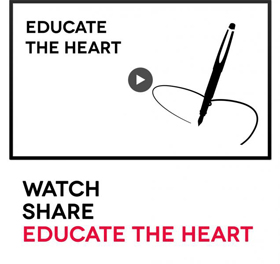
Comments
Post new comment